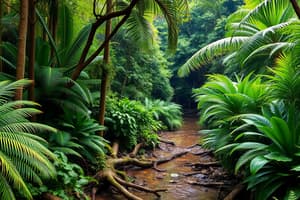Podcast
Questions and Answers
Define biodiversity.
Define biodiversity.
The variety of organisms living in a particular area (plants and animals).
Describe the biodiversity in the TRF.
Describe the biodiversity in the TRF.
Rainforests have extremely high biodiversity - they contain around 50% of the world's plant, animal and insect species.
Describe the biodiversity in the Taiga.
Describe the biodiversity in the Taiga.
Taiga forests have much lower biodiversity than tropical forests - many areas of forest contain a single type of tree, e.g., pine, spruce, fir.
How old is the TRF and how does this affect the biodiversity in the TRF?
How old is the TRF and how does this affect the biodiversity in the TRF?
How old is the Taiga and how does this affect the biodiversity in the Taiga?
How old is the Taiga and how does this affect the biodiversity in the Taiga?
Describe the structure of the rainforest and how this affects biodiversity in the TRF.
Describe the structure of the rainforest and how this affects biodiversity in the TRF.
Describe the structure of the Taiga and how this affects biodiversity in the Taiga.
Describe the structure of the Taiga and how this affects biodiversity in the Taiga.
Describe the climate of the TRF and how this affects the productivity of the TRF.
Describe the climate of the TRF and how this affects the productivity of the TRF.
Describe the climate of the Taiga and how this affects the productivity of the Taiga.
Describe the climate of the Taiga and how this affects the productivity of the Taiga.
What is the NPP?
What is the NPP?
When is productivity highest?
When is productivity highest?
What is the NPP for the TRF?
What is the NPP for the TRF?
What is the NPP for the Taiga?
What is the NPP for the Taiga?
Describe food webs in the TRF.
Describe food webs in the TRF.
Describe food webs in the Taiga and explain why they are so.
Describe food webs in the Taiga and explain why they are so.
Examples of biotic factors.
Examples of biotic factors.
Examples of abiotic factors.
Examples of abiotic factors.
How are the abiotic and biotic factors related in the TRF and Taiga?
How are the abiotic and biotic factors related in the TRF and Taiga?
Give some examples of biotic-abiotic relationships in the TRF.
Give some examples of biotic-abiotic relationships in the TRF.
Give some examples of biotic-abiotic relationships in the Taiga.
Give some examples of biotic-abiotic relationships in the Taiga.
Flashcards are hidden until you start studying
Study Notes
Biodiversity Definition
- Biodiversity refers to the variety of organisms, including plants and animals, living in a specific area.
Biodiversity in Tropical Rainforests (TRF)
- Tropical rainforests possess extremely high biodiversity, housing approximately 50% of the world’s species of plants, animals, and insects.
Biodiversity in Taiga
- Taiga forests have significantly lower biodiversity compared to tropical forests, often dominated by a single tree species such as pine or spruce.
Age and Biodiversity of TRF
- The tropical rainforest biome has existed for around 10 million years, allowing extensive time for species evolution and specialization due to stable climatic conditions.
Age and Biodiversity of Taiga
- The Taiga was predominantly ice-covered until about 15,000 years ago, limiting the time species had to adapt to the current colder climate.
Structure of the Rainforest
- The complex, layered structure of rainforests creates diverse habitats, promoting a wide range of plant and animal development.
Structure of the Taiga
- The Taiga's simpler structure leads to fewer distinct habitats, resulting in a reduced variety of species.
Climate of TRF
- The rainforest climate is consistently hot and wet throughout the year, providing optimal conditions for rapid growth and high biomass production, making it a highly productive environment.
Climate of Taiga
- Taiga forests are less productive due to slow plant growth and a short summer growing season, making food scarcity a continual challenge.
Net Primary Productivity (NPP)
- NPP quantifies the amount of new organic material produced (biomass) in a biome annually, expressed in grams per square meter.
Factors Influencing Productivity
- Maximum productivity occurs in environments with abundant sunlight, high temperatures, and significant precipitation.
NPP of the TRF
- Tropical rainforests feature an NPP of 2200 g/m²/year.
NPP of Taiga
- The NPP for taiga forests is notably lower at 800 g/m²/year.
Food Webs in TRF
- TRF food webs are intricate and complex, featuring numerous linkages among various species.
Food Webs in Taiga
- Taiga food webs are simpler due to lower biodiversity, with many species adapting territories for summer feeding and migration, leading to seasonal food web variations.
Examples of Biotic Factors
- Biotic factors include living elements such as animals, plants, mushrooms, and bacteria.
Examples of Abiotic Factors
- Abiotic factors encompass non-living components like water, soil, light, minerals, wind, air, temperature, and pollution.
Relationship Between Biotic and Abiotic Factors
- Biotic and abiotic factors are interdependent; changes in one factor can significantly impact others within both ecosystems.
Biotic-Abiotic Relationships in TRF
- Trees stabilize soil and prevent erosion through dense cover; loss of trees leads to increased erosion and soil leaching.
- Symbiotic interactions, such as agoutis burying Brazil nut tree nuts, highlight species interdependence and the potential impact of extinction on ecosystems and livelihoods.
- Deforestation diminishes CO2 absorption, exacerbating greenhouse gas effects and climate change.
Biotic-Abiotic Relationships in Taiga
- Plants provide nutrients for consuming animals, which in turn aid plant reproduction through seed dispersal via dung.
- Herbivores like reindeer rely on specific vegetation and migrate as necessary; carnivores like wolves follow the herbivores.
- Ecosystem changes, such as deforestation, can lead to melting permafrost, flooding, and subsequent methane emission, contributing to global warming and threatening biodiversity.
Studying That Suits You
Use AI to generate personalized quizzes and flashcards to suit your learning preferences.




